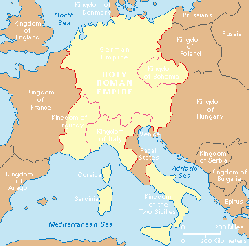From The Peopling of New York City
The First German Settlers
The first group of Germans to settle in America were a group of German Quakers and Mennonites from the Rhineland led by Francis Daniel Pastorius, a lawyer who acted as the agent for the land purchase in Pennsylvania. The main reason for this migration was the appeal of America's promise of land and religious freedom. Thus, in 1683, Pastorius arrived in Philadelphia, Pennsylvania to negotiate the purchase of land from William Penn, the proprietor of the colony, to build a settlement. Then, in the same year, thirteen families onboard the Concord sailed to Philadelphia from Germany and settled in their new home: "Germantown."
The Big One
The decades following the first German settlement in America brought only a small amount of new settlers. However, by 1709 the first huge wave of Germans were making their way across the Atlantic Ocean - this time for the appeal of a higher standard of living. These Germans were not all Quakers; in fact, they were mostly Lutheran Germans who resided in the Holy Roman Empire.
For most of the rural population, the economy and source of living revolved around agriculture. Thus, factors such as weather and human interactions can drastically change the outcomes of the crops and determine the prosperity of the year. Unfortunately, the early eighteenth century produced both war and bad weather that destroyed crops, killed vast numbers, and left the rest of the population starving. With no other option available, the Germans had to move up the Rhine River to seek aid from Great Britain, where rumors of free passage and land in America were granted by Queen Anne. However, as soon as the Germans arrived, they were turned back. What seemed to be a once-in-a-lifetime opportunity turned out only to be a misunderstanding in the Britain's efforts to encourage people to settle in Britain. Because the Germans had no other option than to seek the aid of Britain, they could not return to their homeland and the economical crisis they were facing. Thus, most of the Germans remained in Britain, settling temporarily until their situations could be resolved.
With so many unexpected occupants, Queen Anne had to devise a plan to accommodate for the overwhelming number of Germans temporarily residing in large refugee camps on the outskirts of London. Thus, the government promoted several passages to nearby countries such as Ireland and England. Still, many remained in hopes of one day acquiring the passage to America. That day came in 1710, when Queen Anne finally passed a plan to provide 3,000 Germans with passage to America and 25-acres of land in return for several years' labor once they were in America. From then on, a cascade of Germans flocked to the Britain's immigration agencies to apply and receive permission for immigration to America. [1]
References
- ↑ Otterness, Philip. Becoming German: The 1709 Palatine Migration to New York. Cornell University Press, 2004.
- Return to Historical Development
- Return to Germans
